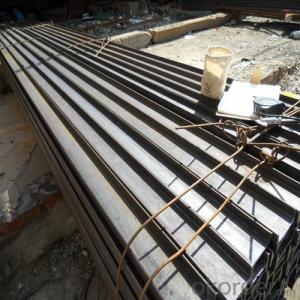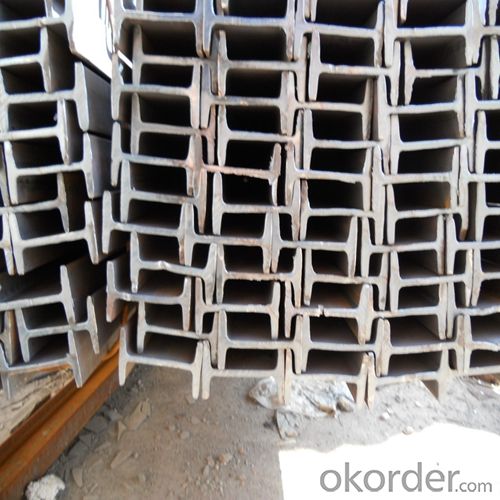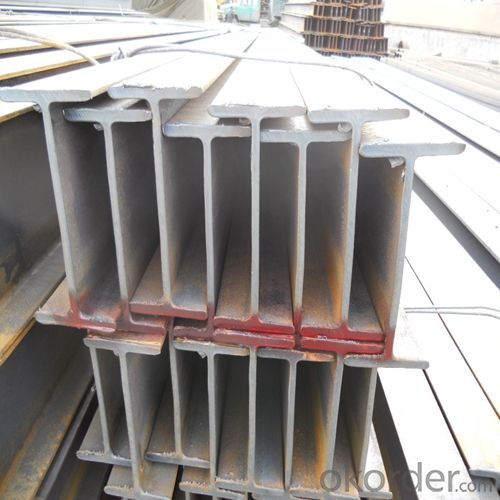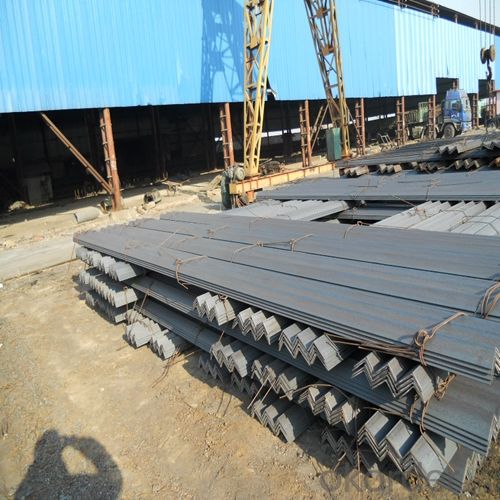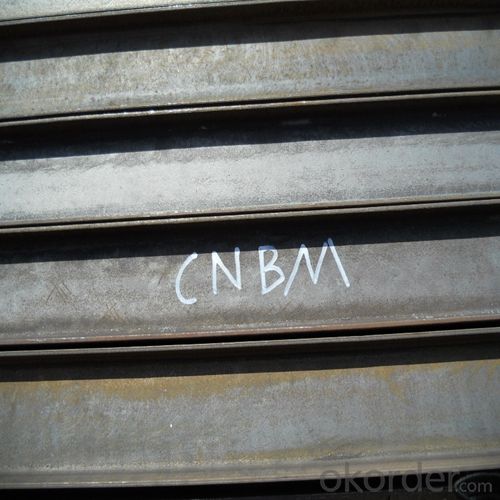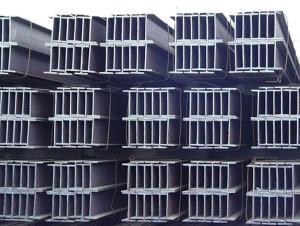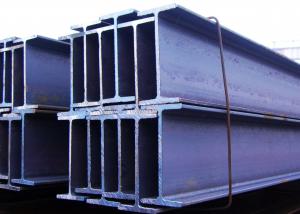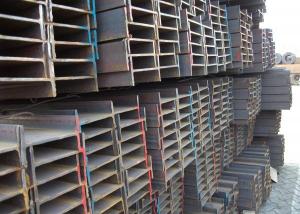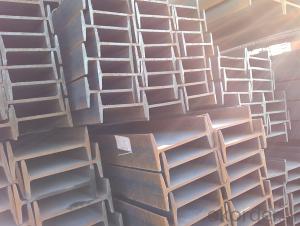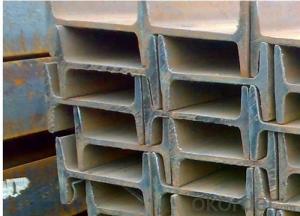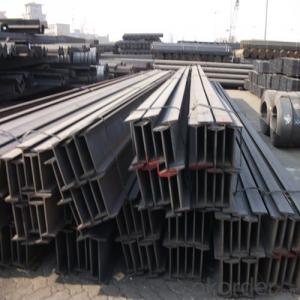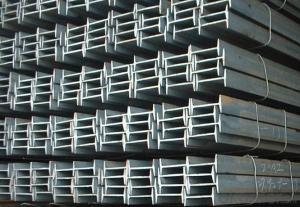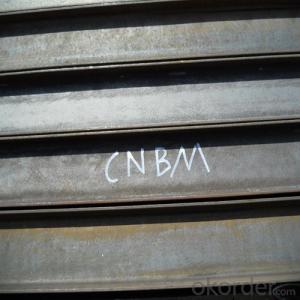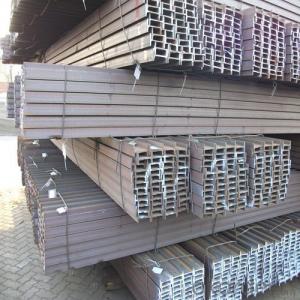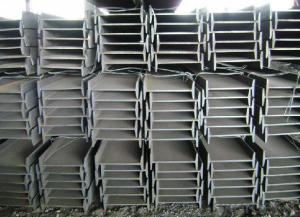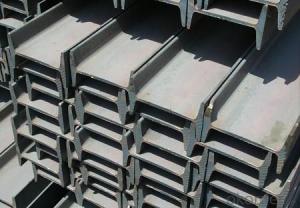Hot Rolled Steel I-Beam IPE IPEAA EN10025 S235JR with Good Price Made In China
- Loading Port:
- Tianjin
- Payment Terms:
- TT OR LC
- Min Order Qty:
- 100 m.t.
- Supply Capability:
- 30000 m.t./month
OKorder Service Pledge
OKorder Financial Service
You Might Also Like
Product Specifications:
Manufacture: Hot rolled
Grade: Q195 – 235
Certificates: ISO, SGS, BV, CIQ
Length: 6m – 12m, as per customer request
Packaging: Export packing, nude packing, bundled
Chinese Standard (H*W*T) | Weight (Kg/m) | 6m (pcs/ton) | Light I (H*W*T) | Weight (Kg/m) | 6m (pcs/ton) | Light II (H*W*T) | Weight (Kg/m) | 6M |
100*68*4.5 | 11.261 | 14.8 | 100*66*4.3 | 10.13 | 16.4 | 100*64*4 | 8.45 | 19.7 |
120*74*5.0 | 13.987 | 11.9 | 120*72*4.8 | 12.59 | 13.2 | 120*70*4.5 | 10.49 | 15.8 |
140*80*5.5 | 16.89 | 9.8 | 140*78*5.3 | 15.2 | 10.9 | 140*76*5 | 12.67 | 13.1 |
160*88*6 | 20.513 | 8.1 | 160*86*5.8 | 18.46 | 9 | 160*84*5.5 | 15.38 | 10.8 |
180*94*6.5 | 24.143 | 6.9 | 180*92*6.3 | 21.73 | 7.6 | 180*90*6 | 18.11 | 9.2 |
200*100*7 | 27.929 | 5.9 | 200*98*6.8 | 25.14 | 6.6 | 200*96*6.5 | 20.95 | 7.9 |
220*110*7.5 | 33.07 | 5 | 220*108*7.3 | 29.76 | 5.6 | 220*106*7 | 24.8 | 6.7 |
250*116*8 | 38.105 | 4.3 | 250*114*7.8 | 34.29 | 4.8 | 250*112*7.5 | 28.58 | 5.8 |
280*122*8.5 | 43.492 | 3.8 | 280*120*8.2 | 39.14 | 4.2 | 280*120*8 | 36.97 | 4.5 |
300*126*9 | 48.084 | 3.4 | 300*124*9.2 | 43.28 | 3.8 | 300*124*8.5 | 40.87 | 4 |
320*130*9.5 | 52.717 | 3.1 | 320*127*9.2 | 48.5 | 3.4 | |||
360*136*10 | 60.037 | 2.7 | 360*132*9.5 | 55.23 | 3 |
Appications of IPE Beam
1. Supporting members, most commonly in the house raising industry to strengthen timber bears under houses. Transmission line towers, etc
2. Prefabricated structure
3. Medium scale bridges
4. It is widely used in various building structures and engineering structures such as roof beams, bridges, transmission towers, hoisting machinery and transport machinery, ships, industrial furnaces, reaction tower, container frame and warehouse etc.
Package & Delivery of IPE Beam
1. Packing: it is nude packed in bundles by steel wire rod
2. Bundle weight: not more than 3.5MT for bulk vessel; less than 3 MT for container load
3. Marks: Color marking: There will be color marking on both end of the bundle for the cargo delivered by bulk vessel. That makes it easily to distinguish at the destination port.
4. Tag mark: there will be tag mark tied up on the bundles. The information usually including supplier logo and name, product name, made in China, shipping marks and other information request by the customer.
If loading by container the marking is not needed, but we will prepare it as customer request.
FAQ:
Q1: Why buy Materials & Equipment from OKorder.com?
A1: All products offered byOKorder.com are carefully selected from China's most reliable manufacturing enterprises. Through its ISO certifications, OKorder.com adheres to the highest standards and a commitment to supply chain safety and customer satisfaction.
Q2: How do we guarantee the quality of our products?
A2: We have established an advanced quality management system which conducts strict quality tests at every step, from raw materials to the final product. At the same time, we provide extensive follow-up service assurances as required.
Q3: How soon can we receive the product after purchase?
A3: Within three days of placing an order, we will begin production. The specific shipping date is dependent upon international and government factors, but is typically 7 to 10 workdays.
Q4: What makes stainless steel stainless?
A4: Stainless steel must contain at least 10.5 % chromium. It is this element that reacts with the oxygen in the air to form a complex chrome-oxide surface layer that is invisible but strong enough to prevent further oxygen from "staining" (rusting) the surface. Higher levels of chromium and the addition of other alloying elements such as nickel and molybdenum enhance this surface layer and improve the corrosion resistance of the stainless material.
Q5: Can stainless steel rust?
A5: Stainless does not "rust" as you think of regular steel rusting with a red oxide on the surface that flakes off. If you see red rust it is probably due to some iron particles that have contaminated the surface of the stainless steel and it is these iron particles that are rusting. Look at the source of the rusting and see if you can remove it from the surface.
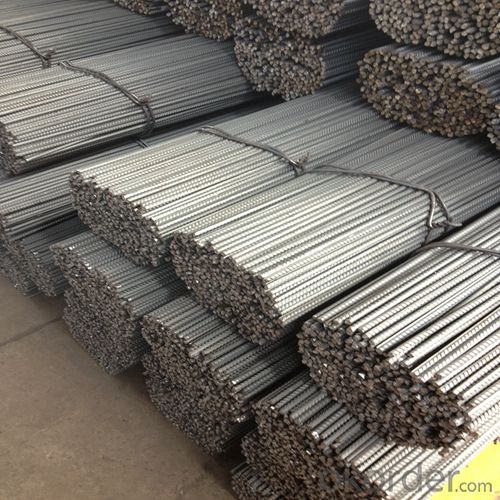
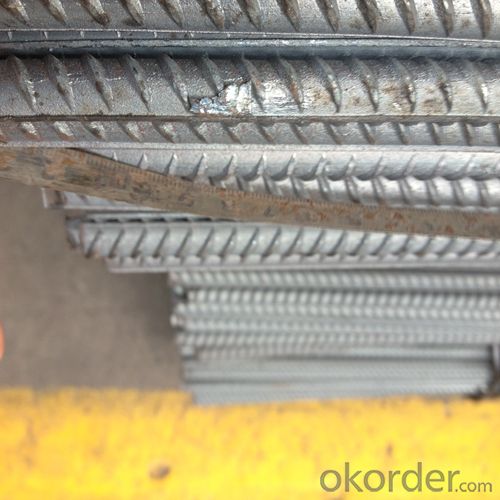
- Q: What are the factors that affect the cost of steel I-beams?
- Several factors influence the cost of steel I-beams. Firstly, the price is affected by the availability and demand of raw materials, such as iron ore, scrap metal, and alloys. Fluctuations in the global market can cause the cost of these materials to vary, ultimately impacting the price of the beams. The manufacturing process also plays a significant role in determining the cost. This involves various steps, including melting, casting, rolling, and shaping. The efficiency and complexity of these processes can influence the final price. Advancements in technology that streamline production can lead to lower costs, while outdated machinery or labor-intensive methods may increase the price. Transportation costs are another factor that affects the overall cost of steel I-beams. Due to their weight and size, specialized equipment and transportation services are required for delivery. Factors such as shipping distances, fuel prices, and logistics can all contribute to transportation costs, which ultimately impact the price of the product. Market demand also plays a role in the cost of steel I-beams. When there is high demand for construction projects or infrastructure development, the price of the beams may increase due to market forces. Conversely, during periods of low demand or economic downturns, prices may decrease as manufacturers compete for limited projects. Lastly, external factors such as government regulations and taxes can influence the cost of steel I-beams. Tariffs, import duties, or trade barriers imposed by governments can raise the price of imported steel, thereby affecting the overall cost of steel I-beams in the market. In conclusion, the cost of steel I-beams is influenced by various factors, including raw material prices, manufacturing processes, transportation costs, market demand, and government regulations. It is important for both manufacturers and consumers to understand these factors in order to assess the pricing dynamics of steel I-beams.
- Q: Can steel I-beams be used for chemical processing plants?
- Yes, steel I-beams can be used for chemical processing plants. Steel is a commonly used material in these types of industrial applications due to its strength, durability, and resistance to corrosion. I-beams, specifically, are often used in structural framing to provide support and stability to the overall structure of the plant. Chemical processing plants typically involve the handling and processing of various chemicals and substances, some of which can be highly corrosive or hazardous. Steel, especially when coated or treated with corrosion-resistant materials such as galvanization or specialized coatings, can withstand the harsh conditions found in chemical processing environments. Additionally, steel I-beams offer several advantages for chemical processing plants. They have a high load-bearing capacity, allowing them to support heavy equipment, piping, and storage tanks. The flexibility and versatility of steel make it easier to construct complex designs and accommodate the changing needs of the plant. However, it is important to note that the specific requirements of each chemical processing plant may vary, and it is crucial to consider factors such as the type of chemicals being processed, temperature, pressure, and other environmental conditions. Consulting with structural engineers, architects, and relevant experts is recommended to ensure the appropriate selection, design, and installation of steel I-beams for a chemical processing plant.
- Q: How do steel I-beams perform in terms of vibration insulation?
- Despite their excellent structural strength and load-bearing capacity, steel I-beams may not be the most effective choice when it comes to vibration insulation. Their rigid and inflexible nature tends to transmit vibrations rather than absorb or dampen them. Consequently, when exposed to vibrations caused by heavy machinery, earthquakes, or nearby traffic, steel I-beams can propagate these vibrations throughout the structure, potentially causing discomfort, noise, and even structural damage. To enhance the vibration insulation capabilities of steel I-beams, various measures can be taken. One commonly used approach is the incorporation of vibration isolation materials or techniques. These can involve the utilization of specialized rubber pads, foam inserts, or flexible connectors positioned between the steel beams and the surrounding structure. These materials and techniques are specifically designed to absorb and dampen vibrations, thereby reducing their transmission through the building. Another option involves implementing structural modifications that enhance the vibration insulation properties of steel I-beams. For instance, adding additional mass to the beams, such as by attaching concrete or other heavy materials, can help mitigate the transmission of vibrations. Additionally, introducing damping elements like tuned mass dampers or viscoelastic materials can effectively dissipate and attenuate vibrations, ultimately improving the overall vibration insulation performance. It is important to recognize that although steel I-beams may not possess inherent vibration insulation capabilities, they are often preferred for their strength, durability, and cost-effectiveness in structural applications. Therefore, a combination of appropriate design, engineering, and additional measures can be employed to minimize the adverse effects of vibrations and optimize the vibration insulation performance of steel I-beams.
- Q: What are the different methods of transporting steel I-beams to construction sites?
- Different methods can be used to transport steel I-beams to construction sites, depending on factors like beam size, weight, and site accessibility. Here are some commonly employed approaches: 1. Flatbed trucks: Steel I-beams are most frequently transported using flatbed trucks. These trucks have a spacious flat platform that facilitates easy loading and unloading of the beams. They are versatile and can transport a wide range of beam sizes and weights. 2. Crane trucks: For larger and heavier I-beams, crane trucks are typically utilized. These trucks feature a hydraulic crane mounted on the back, enabling them to lift and move beams onto the construction site. Crane trucks are particularly useful when site access is limited or when precise beam placement is required. 3. Rail transportation: In cases where the distance between the steel mill and the construction site is considerable, rail transportation may be employed. Specialized railcars, such as flatcars or gondolas, designed for carrying large and heavy loads, are used to transport the steel I-beams. This method is efficient for long-distance transportation, especially when dealing with large quantities of beams. 4. Barge transportation: When construction sites are situated near bodies of water, like rivers or coastal areas, barge transportation is a viable option. Barges are flat-bottomed boats capable of carrying heavy loads. Steel I-beams can be loaded onto barges and transported to the construction site by water, offering an efficient and cost-effective solution for large-scale projects. 5. Air transportation: In exceptional circumstances where time is critical or construction site access is extremely challenging, air transportation may be considered. Helicopters or cargo planes can be employed to lift and transport steel I-beams directly to the construction site. However, due to the high costs involved, this method is typically reserved for urgent or remote projects. When determining the most suitable method of transportation for steel I-beams, it is crucial to consider factors like beam size, weight, and site accessibility. Each method has its advantages and limitations, and the choice will depend on the specific requirements and constraints of the project.
- Q: Can steel I-beams be used in hospitality or hotel construction?
- Yes, steel I-beams can definitely be used in hospitality or hotel construction. In fact, steel is a commonly used material in the construction industry due to its strength, durability, and versatility. Steel I-beams are particularly popular for their ability to support heavy loads and provide structural stability. They are often used in the construction of large buildings like hotels, where the need for a strong and reliable support system is paramount. Steel I-beams can be used for various purposes in hotel construction, such as supporting the weight of the building, creating open floor plans, and providing a framework for the installation of mechanical, electrical, and plumbing systems. Additionally, steel I-beams offer several advantages for hotel construction, including their ability to span long distances without the need for intermediate supports, their resistance to fire and pests, and their ease of installation. Overall, steel I-beams are a viable and popular choice for hospitality or hotel construction projects.
- Q: What is the GB tolerance of I-beam?
- Shape:1, bending degree. The camber of I-beam is not greater than 2mm. per meter, and the total bending is not greater than 0.2% of the total length.2, twist. I-beam shall not be subject to obvious torsion.
- Q: What is the maximum span that steel I-beams can support without additional support?
- Several factors, such as the dimensions of the beam, the material strength, and the load it must bear, contribute to the maximum span that steel I-beams can support without extra support. However, I-beams are renowned for their outstanding load-bearing capacity and are commonly utilized in construction projects due to their ability to cover long distances. Engineers typically employ structural analysis techniques and take into account the beam's moment of inertia, section modulus, and the load it must bear to determine the maximum span. Consulting engineering manuals and codes, such as those provided by the American Institute of Steel Construction (AISC), can also offer guidelines and formulas to calculate maximum spans based on specific design criteria. It is important to note that although I-beams possess impressive span capabilities, they may still require additional support or reinforcement depending on the particular application and load requirements. For example, excessive loads, including heavy machinery or concentrated weights, may necessitate the inclusion of extra beams, columns, or other structural elements to ensure safety and structural integrity. Ultimately, seeking guidance from a structural engineer or a professional well-versed in steel beam design is crucial for accurately determining the maximum span that a steel I-beam can support without extra support in a given application.
- Q: Are steel I-beams suitable for supporting rooftop helipads?
- Steel I-beams are indeed suitable for supporting rooftop helipads. I-beams are known for their strength and load-bearing capabilities, making them ideal for such structural applications. Steel is a commonly used material in construction due to its high tensile strength and durability, making it capable of withstanding the weight and impact associated with helicopter landings and takeoffs. Additionally, steel I-beams can be designed and engineered to meet specific load requirements, ensuring the necessary support for a helipad. The versatility and reliability of steel I-beams make them a popular choice for supporting rooftop helipads in various buildings and structures.
- Q: Can steel I-beams be used in the construction of high-rise buildings?
- Yes, steel I-beams can be used in the construction of high-rise buildings. Steel I-beams are widely used in the construction industry due to their strength, durability, and cost-effectiveness. These beams have a high strength-to-weight ratio, making them ideal for supporting heavy loads over long spans. High-rise buildings require structural elements that can withstand significant loads and provide stability, and steel I-beams meet these requirements. They can be used as columns or beams to support the weight of the floors above and distribute the loads throughout the structure. Additionally, steel I-beams can be easily fabricated and assembled, allowing for efficient construction processes in high-rise buildings. Overall, steel I-beams are a popular choice for high-rise construction due to their strength, versatility, and ability to support the complex structural requirements of these buildings.
- Q: Can steel I-beams be used in exterior applications?
- Yes, steel I-beams can be used in exterior applications. Steel I-beams are commonly used in construction for their strength and durability, making them suitable for exterior applications where load-bearing capabilities are required. They are often used in the construction of bridges, highways, and industrial buildings, as well as for supporting large structures such as stadiums and warehouses. Steel I-beams can withstand harsh weather conditions, including extreme temperatures, high winds, and heavy rain or snowfall, making them a reliable choice for outdoor applications. Additionally, steel can be coated or galvanized to protect against corrosion, further enhancing its suitability for exterior use.
Send your message to us
Hot Rolled Steel I-Beam IPE IPEAA EN10025 S235JR with Good Price Made In China
- Loading Port:
- Tianjin
- Payment Terms:
- TT OR LC
- Min Order Qty:
- 100 m.t.
- Supply Capability:
- 30000 m.t./month
OKorder Service Pledge
OKorder Financial Service
Similar products
Hot products
Hot Searches
Related keywords
